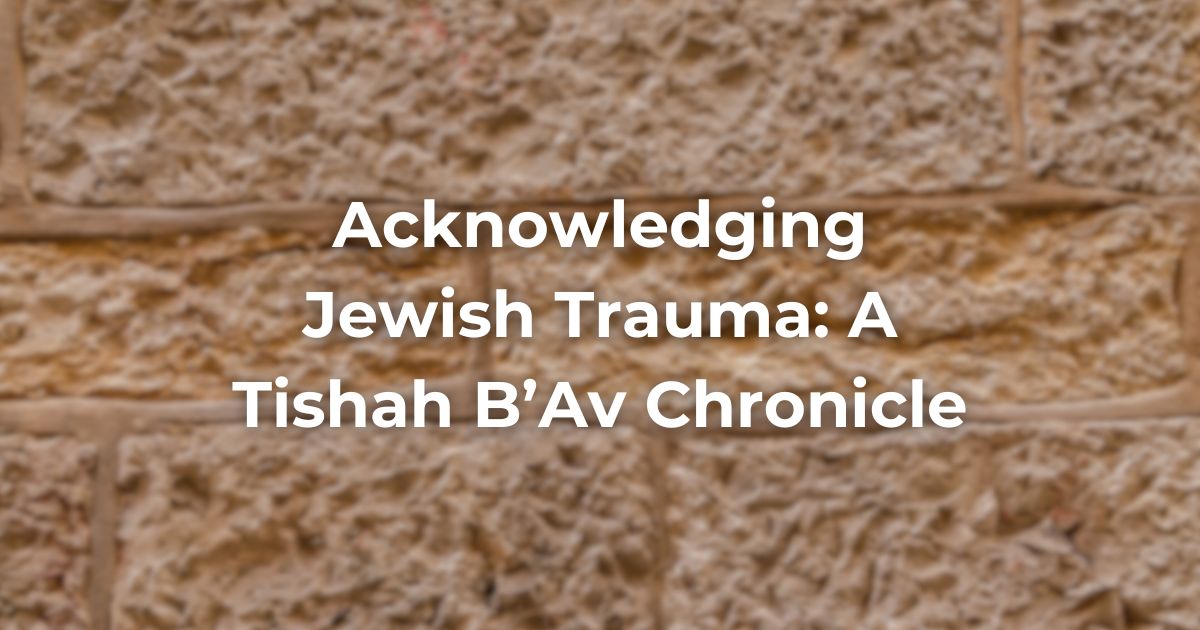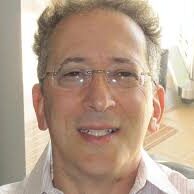Tishah B’Av, one of only two full fasts in Judaism, commemorates tragedies that befell our people.
It originally served to focus upon two specific tragedies: the destruction of the Beit HaMikdash (Holy Temple) and the loss Jewish independence and autonomy. Solomon’s Temple was destroyed at the hands of the Babylonians 586 B.C.E., and the rebuilt temple (the Second Temple) was destroyed by the Romans in 70 C.E. On Tishah B’Av Jews sit on the floor—our hearts are physically and spiritually low—and reciting the biblical book of Eichah (Lamentations) and qinot (dirges) to help us process our communal grief.
Over time many communities folded tragic outbursts of antisemitism into their Tishah B’Av commemorations, either reading their own experience into received texts or by writing qinot in response to their specific tragedies. Qinot have been written in response to attacks on Jewish communities during the Crusades (11th-14th C.), the public burning of the TalmudReferring to one of two collections, the Jerusalem and Babylonian Talmuds, edited in the 6th century, that contains hundreds of years of commentary, discussion, and exploration of the ideas in the Mishnah. One could describe it as Mishnah + Gemara = Talmud Read more in Paris (1242), the expulsion of the entire Jewish population of Spain (1492), and much more.
In recent times, qinot have been written to commemorate other tragic occasions, including the Shoah (Holocaust), the murder of Yitzhak Rabin, and October 7, 2023. This is the case such that editors had to make decisions as to which qinot to include in their respective editions of the Tishah B’Av prayer book.
Tishah B’Av is not about any specific tragedies or antisemitic violence.
As former Jewish Theological Seminary Chancellor Ismar Schorsch states in our Tishah B’Av Siddur (Rabbinical Assembly 2003), “Tishah B’Av is no longer about any single historical calamity.” Thus, any calamity that caused national trauma, particularly a trauma that lasted for some time or, more importantly, one whose afterlife continued to affect the Jewish community’s collective n’shamah (soul)—that was etched into our communal psyche—is a Tishah B’Av calamity. Tishah B’Av is the repository for our communal grief for all past Jewish tragedies, and not merely the original or “official” ones.
It is also significant that the tradition of Tishah B’Av was to incorporate these traumas, whether or not they actually occurred on or near Tishah B’Av. So, for example, the Alhambra Decree expelling Jews from Spain was not promulgated on Tishah B’Av (as so many assume) but on March 31, 1492, months before Tishah B’Av. Nonetheless, it is rightly included in Tishah B’Av because what else were the Jews of Spain thinking of on Tishah B’Av that year—or any year thereafter. It was a trauma that affected all Jews.
It’s the trauma experienced by our people that renders an event a Tishah B’Av event, and not the date. As such, Tishah B’Av serves as the Memorial Day of the Jewish People.
Not all of these events are commemorated in our Tishah B’Av liturgy. Yet all of these events affected our people’s n’shamah, our psyche. And naming our pain, naming tragedies, and naming what is tragic is the first step toward a deeper healing of historic Jewish trauma and grief, and the first steps toward an action plan toward not only healing but prevention.
We now live with the trauma of October 7, with the trauma of Israel at war, and with the trauma of global antisemitism. We need Tishah B’Av more than ever. Not merely to rehearse what Babylonians and Romans did but to see our present in terms of our past experiences. This helps us draw upon our will, tenacity, and hope to survive, and how to memorialize and grieve in a way that promotes a collective sense of healing and provides a path forward.
The more tragedies we can name, the more we have to draw upon and so the more healing we can begin to effectuate. And, because we live in a world where hate is still a strong force, it is important for us to remember history, be today’s witnesses, and draw appropriate lessons so that we can forge a world together, one with no room for hate of any kind.
(A brief note on usage: This document could be used for study, reflection, or for Tishah B’Av gatherings, whether in a home or in a more public space. At gatherings, people could be stationed at various points in a semi-darkened room who alternate reading the entries, to give a sense of the randomness, omnipresence, and arbitrariness of hate through history.)
| 1200 BCE | G!d decreed that the Israelites wander for 40 years for heeding the 10 scouts’ negative report of the Promised Land, one year for each day the scouts were in Canaan, contending that this day–Tishah B’av–will be forever a day of disaster for our people. |
| 722 | The Assyrians captured the northern realm, Israel. Many of these “ten lost tribes” were exiled as slaves. Others managed to escape to the southern realm of Judah and eventually lost their tribal cultural distinctiveness. |
| 587 | Armies of the Neo-Babylonian Empire (under King Nebuchadnezzar) destroyed King Solomon’s Temple; we lost our sovereignty, and another exile into slavery began. |
| 174-167 | Seleucid (Syrian) Greek King Antiochus IV outlawed traditional Jewish practices and persecuted practicing Jews. Mattathias led an insurrection against the foreign rulers, which eventually restored our civil rights and our Temple rites and established Hanukkah. |
| 66-73 CE | First Jewish Revolt against Rome. Emperor Titus’ legions destroyed the Second Temple, murdered thousands, and exiled survivors into slavery in Europe. At the last holdout, Masada, Jews committed mass suicide rather than cede to Roman tyranny. |
| 115-117 | Second Jewish Revolt against Rome. In the Kitos Revolt, the Romans decisively overwhelmed the Jews in Alexandria and elsewhere. |
| 132-135 | Third Revolt against Rome. Betar, the last stronghold of the Bar Kochba rebellion (under Rabbi Akiva’s influence), is captured, with over 100,000 Jews killed. Between 66-135, over 1,000,000 Jews perish and about 100,000 taken as slaves. |
| 136 | Roman emperor Hadrian plowed over Jerusalem and rebuilt and renamed it Aelia Capitolina, establishing a pagan sanctuary on the Temple mount, and forbidding Jews from entering the city. Eretz Yisrael was renamed Palestina (“Philistine” Land). |
| 325 | The Council of Nicaea officially declared Jews the “adversaries” of Christianity. Jews to continued to exist in seclusion and humiliation for the glory of the Church. |
| 529-559 | Byzantine Emperor Justinian the Great established the principle of Servitus Judaeorum (Servitude of the Jews) and enacted restrictive civil (e.g. no testifying against Christians) and religious laws (e.g. prohibited Hebrew prayer). |
| 608-610 | Massacres of Jews across the Byzantine Empire |
| 682 | King Erwig (Visigoths) issued 28 anti-Jewish laws, and called for “the utter extirpation of the pest of the Jews.” |
| 874-888 | Basil I ordered the baptism of all Byzantine Jew and reinforced laws prohibiting Jews from holding civic or military positions. The Church council in Metz forbade Jews and Christians from eating together. |
| 1012 | Emperor Henry II expelled Jews from Mainz, the first persecution of Jews in Germany. |
| 1078 | The Council of Girona ruled that Jews must pay taxes to support the Catholic Church. |
| 1096 | First Crusade—Over 10,000 Jews are killed in the Rhineland communities (SHU”M = Speyer, Worms, & Mainz) in the first month alone, along with French Jewish communities. Their slogan was “Why fight Christ’s enemies abroad when they are living among us?” |
| 1146-1149 | The Second Crusade destroyed Jewish communities in Germany and France. The ancient accusation of Blood Libel was revived in 1144 in Norwich, England. Later 31 Jews were burned at the stake in Blois, France in 1171. |
| 1182 | King Philip Augustus of France expelled all Jews. |
| 1189-1192 | The Third Crusade led to bloody anti-Jewish rioting all over England. Massacres occurred at York, Norwich, and elsewhere. |
| 1215 | The Fourth Lateran Council (headed by Pope Innocent III) introduced “the Jewish Badge.” Jews had to wear yellow stars and sharp-pointed hats. |
| 1242 | The Talmud and other Holy Writings were publicly burned in Paris, ordered by the Inquisition. |
| 1243 | First known charge of Host Desecration. The entire Jewish community of Beelitz was burned at the stake. In 1298 more than 140 Jewish communities were forcibly converted or decimated for host desecration. |
| 1290 | King Edward expelled all Jews from England, the first of the large general expulsions of Jews in the Middle Ages |
| 1306 | Jews are expelled from France. |
| 1347-1351 | The Bubonic (Black) Plague—60 major and 150 minor Jewish communities were exterminated in Spain, France, Germany, and Austria. Many others were expelled, settling in Poland. Jews were blamed for “poisoning the wells” and for Devil worship. |
| 1478 | The Spanish Inquisition started to “reclaim the souls” of Jews by burning their bodies. |
| 1492 | The Alhambra Decree: Jews were expelled from Spain. |
| 1496-1498 | The Jews were expelled from Portugal and Andorra. Mass forced conversions. In 1506 there were massacres of conversos. |
| 1519 | The Protestant Church was created in Germany by Martin Luther, a virulent antisemite. |
| 1555-1630 | The Jews of Italy suffered. Those in Rome and Florence were forced into a ghetto; those in Mantua were expelled. Later, the Jews of Padua suffer a pogrom (1684). |
| 1648-1654 | Ukrainian Cossacks under Bogdan Chmielnicki massacred up to 100,000 Jews during the Wars of Poland against Sweden and Russia, and over 300 Jewish communities were destroyed. Chmielnicki became and remains a national hero in Ukraine’s. |
| 1670 | The Jews were forced out of Vienna. |
| 1684 | A two-week pogrom erupted against the Jews of Padua. |
| 1834 | The Spanish Inquisition, instituted in 1478, was lifted after 256 years. |
| 1878 | Adolf Stoecker in Germany established modern political antisemitism. |
| 1881-1884 | Pogroms swept through tsarist Russia. |
| 1894-1906 | Captain Alfred Dreyfus, a Jew, was sentenced to life imprisonment on the harsh Devil’s Island, although the actual traitor was known. The Dreyfus Affair exemplifies miscarriage of justice and the insidiousness of antisemitism–and continues to divide the French. |
| 1903 | Earliest known publication of the Protocols of the Elders of Zion, a fabricated text claiming to lay out the Jewish plan for global domination. Disseminated worldwide, Henry Ford (beginning in 1920) published and distributed them throughout the United States. |
| 1911-13 | In the Beilis Affair, Menahem Mendel Beilis was convicted of ritual murder in Kyiv. Eventually acquitted, the case exposed rampant antisemitism in the Russian Empire. |
| 1914-1918 | World War I broke out, during which many Jewish communities were wiped out in pogroms. |
| 1917-1921 | Pogroms throughout Poland and Ukraine. |
| 1929 | Arab attacks against Jews erupted over the issue of access to the Western Wall. |
| 1933-1945 | The Shoah (Holocaust): Jews are dehumanized and hunted down; some six million are murdered. |
| 1942 | The deportations to Treblinka extermination camp (Poland) began from the Warsaw Ghetto. |
| 1964 | Vatican II ruled that Jews living today would no longer be held responsible for deicide–Jesus’ death, an accusation leveled against Jews since the second century. |
| 1968 | The Alhambra Decree was lifted, ending the 476-year long expulsion of Jews from Spain. |
| 1968-1971 | Half of Poland’s Jews flee due to state-supported antisemitism throughout Poland. |
| 1970-1990 | Neo-Nazi propaganda spread throughout the world denying the Holocaust. |
| 1994 | The Jewish community center in Buenos Aires was bombed, killing 86 and wounding 300 others. |
| 2015 | Spain and Portugal each offer descendants of expelled Jews expelled citizenship, whether or not they return and without yielding their current citizenship. |
| 2018 | The Tree of Life—Or L’Simcha Congregation in Pittsburgh suffered an antisemitic terrorist attack. Eleven were murdered and six injured; it was the deadliest attack ever on a Jewish community in the United States. |
| 2023 | Over 3,000 Hamas (and other) terrorists attacked 21 Israeli communities, murdering at least 1,139 people (38 children) and taking about 250 hostages of all ages. Women were sexually assaulted. The day is known as HaShabbat HaSh’chorah, Black Saturday. |
Author
-

Rabbi Dr. J.B. Sacks (he/him) is the spiritual leader of Congregation Beth Shalom (Palm Desert, California). The first openly LGBTQ+ rabbi in the Conservative Movement, Rabbi Sacks is an advocate for inclusion in Jewish life and social justice. His most recent publication is Psalms in the Key of Healing. Rabbi Sacks is the eighteenth generation of rabbis on his mother’s side and lives with his husband Steven Karash in Palm Desert, California. They have an adult son, Evan.
View all posts






